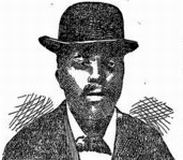The Robert Charles Riots of 1900 were
sparked after African American laborer Robert Charles shot a white
police officer, which led to a manhunt. Twenty-eight people were
killed in the conflict, including Charles. Many more people were
killed and wounded in the riots. The manhunt for Charles began after
an altercation involving Charles, his roommate, and several New
Orleans police officers on Monday, July 23, 1900, and ended when
Charles was killed on Friday, July 27.
Civil Unrest
Louisiana was a racially diverse state at the turn
of the century. Its population was listed at 730,000 'white' and
650,000 'negro' by the Twelfth Census of the United States. Louisiana
law attempted to keep these two populations separate at the end of the
19th century. Plessy vs. Ferguson was originally a Louisiana
case before going to the Supreme Court, and the state of Louisiana had
passed eight Jim Crow laws by 1900.
The effect of segregation laws was clear in the
city of New Orleans at the beginning of the 20th century: "Signs of
increasing animosity between the races were to be seen almost daily in
New Orleans during June and July 1900. Both the police and press
received an unprecedented number of complaints."
Racial tensions were increased by the racist
undertones of New Orleans newspapers, which were "becoming more
stridently racist in their editorial columns and treatment of the news."
The confrontational journalistic practices of Henry J. Hearsay and the
States newspaper caused racial rifts in New Orleans. Hearsay, a
former Major in the Confederate Army, stated in one article that "if [negroes]
listen to the screeds of agitators in the North...the result will be a
race war, and race war means extermination...Then the negro problem of
Louisiana at least will be solved–and that by extermination."
Original Altercation and Pursuit
At approximately 11 p.m. on July 23, 1900, three
white police officers, Sergeant Jules C. Aucion, August T. Mora, and
Joseph D. Cantrelle, investigated “two suspicious looking negroes”
sitting on a porch on the 2800 block of Dryades Street in a
predominantly white neighborhood.
They arrived to find Charles and his roommate, 19-year-old
Leonard Pierce, at the scene. The policemen questioned the two men,
demanding to know what they "were doing and how long they had been
there." One of the two men replied that they were "waiting for a
friend." Charles then stood up, which the police believed to be an
aggressive move. Mora grabbed him and the two struggled. Mora hit
Charles with his billet. Mora and Charles pulled guns and exchanged
shots. Reports vary on who drew first; both men received non-lethal
gunshot wounds. Charles fled the scene, leaving a trail of blood.
Pierce, also armed, was left at the gunpoint of a police officer when
Charles ran.
Charles returned to his residence early the next
morning while the police attempted to track him down. Discovering
where the man lived by interrogating Pierce, Captain Day and a patrol
wagon approached Charles's residence on the 2000 block of Fourth
Street at approximately 3 a.m. on the morning of July 24, 1900. When
the police attempted to apprehend Charles, he fired upon them, hitting
Day with a rifle shot to the heart. Charles shouted, "I will give you
all some," and shot another policeman in the head. The remaining
policemen took refuge in a nearby room while Charles escaped.
Manhunt and Riot
July 24 was the first day that showed signs of
rioting. A crowd of whites gathered on Fourth Street where the
policemen were killed. There were shouts for lynching Charles, but the
crowds dispersed when they were falsely told Charles had been located
and jailed.
On the 25th, Acting Mayor Mehle (Mayor Paul
Capdevielle was out of town) announced a $250 reward for the arrest of
Charles while issuing a proclamation urging peace. New Orleans papers,
particularly the Times-Democrat, helped exacerbate the situation,
blaming the black community for Charles's crimes and calling for
action.
In the following days, several riots occurred as
mobs of armed whites roamed the streets. The night of the 25th caused
the deaths of three blacks and the hospitalization of six more, plus
five whites, and the injury of more than 50 people.
Charles had taken refuge at 1208 Saratoga Street,
where he remained safe from the police until Friday, July 27. The
house was quickly surrounded by police after they were informed of
Charles's location. Throughout the day, men from outside the house
fired upon Charles, who sporadically returned the fire. By the end of
the day, Charles had shot a total of 27 white people in the course of
the week, seven lethally; four of the victims were policemen.
At this point, the police decided to burn down the
building in which Charles was holed up. When attempting to escape the
smoke-filled building, Charles was shot by Charles A. Noiret, a
medical student and member of the special police (a police group of
volunteer citizens). The policemen present continued to shoot Charles,
then dragged him outside where a mob of bystanders beat Charles's body.
Aftermath
Mobs in New Orleans still rampaged after the
killing. Police had difficulty getting the body to the morgue due to
angry white mobs attempting to damage the corpse. Several innocent
African-American people were killed and the Thomy Lafon schoolhouse, "the
best Negro schoolhouse in Louisiana," was burned down. The informant
who told police the whereabouts of Charles, Fred Clark, was shot and
killed several days later by an admirer of Charles, Lewis Forstall.
The events in New Orleans also had an effect
outside of the state. A young white Bostonian, Lillian Jewett, started
the Anti-Lynching League in reaction to Charles's death. Some members
of the group wanted retribution for the killing and called for revenge.
In turn, a group of white New Orleanians formed the Green Turtles, who
threatened Jewett's life.

